Moderate overlap front: original test
Rating applies to 2005-10 models built after November 2004
Tested vehicle: 2005 Volkswagen Jetta GL 4-door
The Volkswagen Jetta sedan was redesigned during the 2005 model year. The new design entered production in December 2004, and the earlier design, which is classified as a small car, was produced through October 2004. Note: information about when a specific vehicle was manufactured is on the certification label typically affixed to the car on or near the driver door.
The frontal offset crash test ratings also apply to the hatchback version of the Jetta, called the Volkswagen Rabbit for the 2006-09 model years and its restyled successor, the Volkswagen Golf and its sporty variant, the Volkswagen GTI, for the 2010-14 model years. The Rabbit, Golf, and GTI are classified as small cars due their shorter overall lengths and lower weights. The ratings also apply to the station wagon version of the Jetta, called the Jetta SportWagen, beginning with 2009 models.
Beginning with the 2011 model year, these ratings do NOT apply to the Volkswagen Jetta sedan, which was redesigned again. Also, the ratings do NOT apply to the Golf and GTI beginning with the 2015 model year. However, the ratings still apply to the Jetta SportWagen, which remains essentially the same as 2009-10 models.
| Overall evaluation | |
|---|---|
| Structure and safety cage | |
| Driver injury measures | |
| Head/neck | |
| Chest | |
| Leg/foot, left | |
| Leg/foot, right | |
| Driver restraints and dummy kinematics |
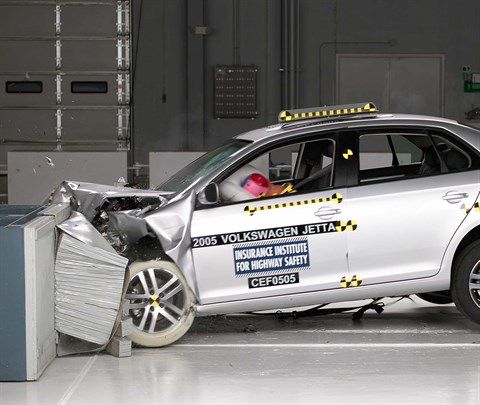
Action shot taken during the frontal offset crash test.
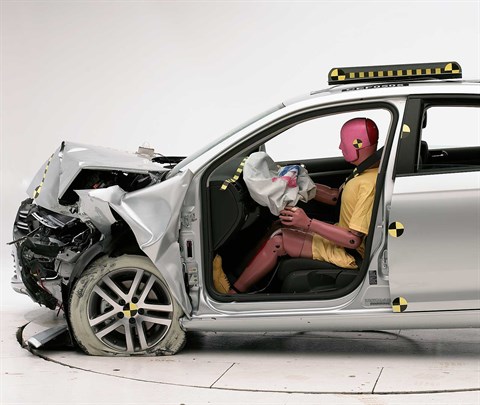
The dummy's position in relation to the steering wheel and instrument panel after the crash test indicates that the driver's survival space was maintained well.
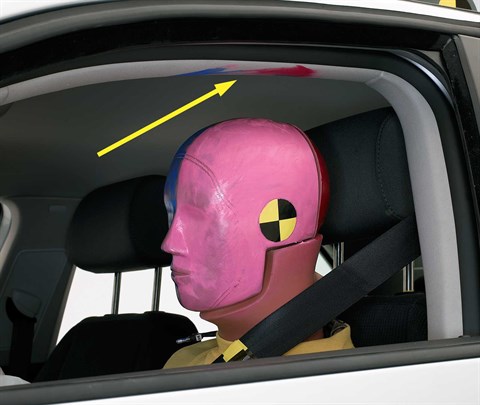
Smeared greasepaint indicates where the dummy's head hit the roof rail during rebound. Head acceleration from this hit was low.
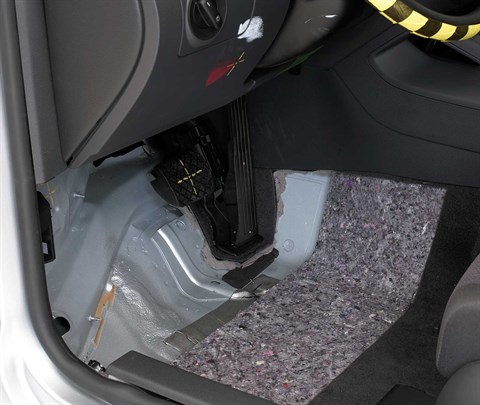
Intrusion into the driver's space was minimal (shown with carpeting removed).
Measures of occupant compartment intrusion on driver side
| Test ID | CEF0505 |
|---|---|
| Footwell intrusion | |
| Footrest (cm) | 7 |
| Left (cm) | 13 |
| Center (cm) | 6 |
| Right (cm) | 3 |
| Brake pedal (cm) | 2 |
| Instrument panel rearward movement | |
| Left (cm) | 1 |
| Right (cm) | 1 |
| Steering column movement | |
| Upward (cm) | 1 |
| Rearward (cm) | -4 |
| A-pillar rearward movement (cm) | 1 |
Driver injury measures
| Test ID | CEF0505 |
|---|---|
| Head | |
| HIC-15 | 266 |
| Peak gs at hard contact | 41 |
| Neck | |
| Tension (kN) | 1.7 |
| Extension bending moment (Nm) | 30 |
| Maximum Nij | 0.50 |
| Chest maximum compression (mm) | 28 |
| Legs | |
| Femur force - left (kN) | 0.1 |
| Femur force - right (kN) | 4.4 |
| Knee displacement - left (mm) | 1 |
| Knee displacement - right (mm) | 3 |
| Maximum tibia index - left | 0.53 |
| Maximum tibia index - right | 0.85 |
| Tibia axial force - left (kN) | 3.7 |
| Tibia axial force - right (kN) | 6.3 |
| Foot acceleration (g) | |
| Left | 89 |
| Right | 144 |
Rating applies to 1999-2005 models built before November 2004
Tested vehicle: 1999 Volkswagen Jetta GLS 4-door
The Volkswagen Jetta and Golf were redesigned during the 1999 model year (the old design continued into the early part of the 1999 model year). The Jetta continued in production through 2005 models manufactured until the end of October 2004 (note: information about when a specific vehicle was manufactured is on the certification label typically affixed to the car on or near the driver door). A redesigned 2005 Jetta was introduced in March 2005 as a midsize car. The Golf redesign will be delayed until late in the 2006 model year.
The Insurance Institute for Highway Safety has evaluated the crashworthiness of a late 1999 model Jetta in a 40 mph frontal offset crash test into a deformable barrier. Note: Immediately after the test, there was a small fire at the base of the B-pillar. The pyrotechnic device in the belt tensioner had ignited sound insulation material. Soon after this incident, the manufacturer recalled all 1999 Jetta/Golf models to fix this problem, so it doesn't affect the crashworthiness evaluation.
| Overall evaluation | |
|---|---|
| Structure and safety cage | |
| Driver injury measures | |
| Head/neck | |
| Chest | |
| Leg/foot, left | |
| Leg/foot, right | |
| Driver restraints and dummy kinematics |
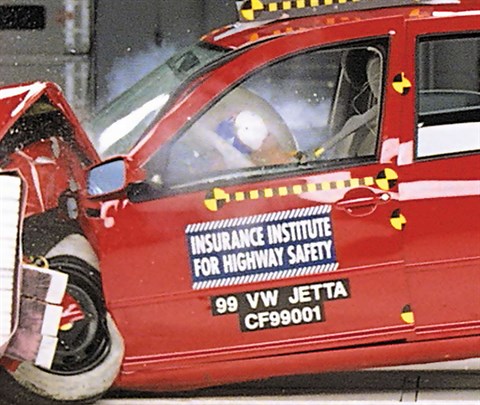
Action shot taken during the frontal offset crash test.
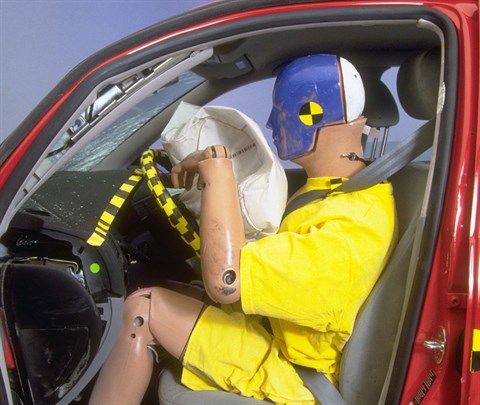
The dummy's position in relation to the steering wheel and instrument panel after the crash test indicates that the driver's survival space was maintained reasonably well.

Little damage occurred in a 5 mph rear-into-pole impact.

Footwell intrusion was minimal to moderate in the offset test.
Measures of occupant compartment intrusion on driver side
| Test ID | CF99001 |
|---|---|
| Footwell intrusion | |
| Footrest (cm) | 17 |
| Left (cm) | 25 |
| Center (cm) | 21 |
| Right (cm) | 13 |
| Brake pedal (cm) | 12 |
| Instrument panel rearward movement | |
| Left (cm) | 8 |
| Right (cm) | 7 |
| Steering column movement | |
| Upward (cm) | 3 |
| Rearward (cm) | 6 |
| A-pillar rearward movement (cm) | 3 |
Driver injury measures
| Test ID | CF99001 |
|---|---|
| Head | |
| HIC-15 | 140 |
| Peak gs at hard contact | 49 |
| Neck | |
| Tension (kN) | 1.3 |
| Extension bending moment (Nm) | 17 |
| Maximum Nij | 0.25 |
| Chest maximum compression (mm) | 32 |
| Legs | |
| Femur force - left (kN) | 4.9 |
| Femur force - right (kN) | 2.8 |
| Knee displacement - left (mm) | 2 |
| Knee displacement - right (mm) | 4 |
| Maximum tibia index - left | 0.76 |
| Maximum tibia index - right | 0.70 |
| Tibia axial force - left (kN) | 0.8 |
| Tibia axial force - right (kN) | 1.4 |
| Foot acceleration (g) | |
| Left | 60 |
| Right | 86 |
Side: original test
Rating applies to 2005-10 models built after November 2004
Tested vehicle: 2005 Volkswagen Jetta GL 4-door with standard front and rear head curtain airbags and standard front seat-mounted torso airbags
The Volkswagen Jetta sedan was redesigned during the 2005 model year. The new design entered production in December 2004, and the earlier design, which is classified as a small car, was produced through October 2004. Note: information about when a specific vehicle was manufactured is on the certification label typically affixed to the car on or near the driver door.
The frontal offset crash test ratings also apply to the hatchback version of the Jetta, called the Volkswagen Rabbit for the 2006-09 model years and its restyled successor, the Volkswagen Golf and its sporty variant, the Volkswagen GTI, for the 2010-14 model years. The Rabbit, Golf, and GTI are classified as small cars due their shorter overall lengths and lower weights. The ratings also apply to the station wagon version of the Jetta, called the Jetta SportWagen, beginning with 2009 models.
Beginning with the 2011 model year, these ratings do NOT apply to the Volkswagen Jetta sedan, which was redesigned again. Also, the ratings do NOT apply to the Golf and GTI beginning with the 2015 model year. However, the ratings still apply to the Jetta Sportwagen, which remains essentially the same as 2009-10 models.
| Overall evaluation | |
|---|---|
| Structure and safety cage | |
| Driver injury measures | |
| Head/neck | |
| Torso | |
| Pelvis/leg | |
| Driver head protection | |
| Rear passenger injury measures | |
| Head/neck | |
| Torso | |
| Pelvis/leg | |
| Rear passenger head protection | |
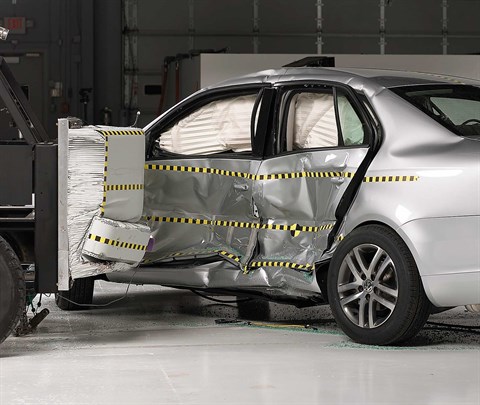
View of the vehicle and barrier just after the crash test.
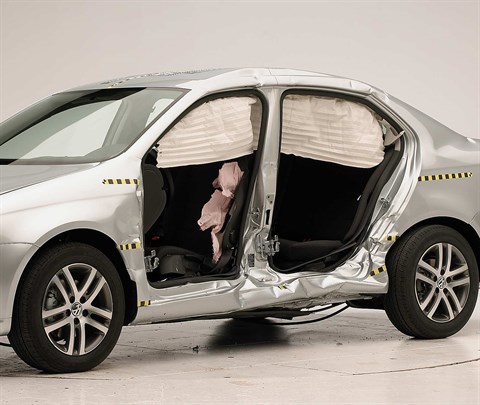
View of the vehicle after the crash with doors removed, showing the side airbags and damage to the occupant compartment.

Action shot taken during the side impact crash test showing the driver dummy's head was protected from being hit by hard structures by the side curtain airbag.
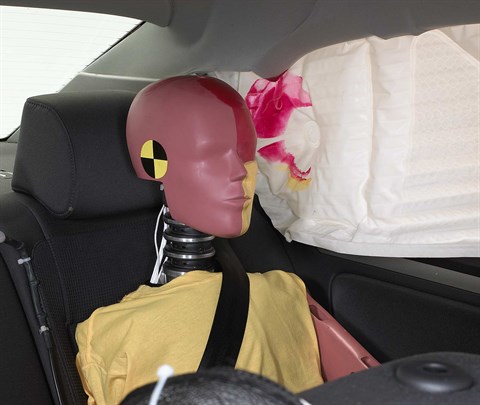
Smeared greasepaint shows where the rear passenger dummy's head was protected by the side airbag.
Measures of occupant compartment intrusion on driver side
| Test ID | CES0506 |
|---|---|
| B-pillar to longitudinal centerline of driver's seat (cm) | -15.5 |
| Negative numbers indicate the amount by which the crush stopped short of the seat centerline. | |
Driver injury measures
| Test ID | CES0506 |
|---|---|
| Head HIC-15 | 302 |
| Neck | |
| Tension (kN) | 0.6 |
| Compression (kN) | 0.5 |
| Shoulder | |
| Lateral deflection (mm) | 36 |
| Lateral force (kN) | 1.7 |
| Torso | |
| Maximum deflection (mm) | 34 |
| Average deflection (mm) | 26 |
| Maximum deflection rate (m/s) | 4.04 |
| Maximum viscous criterion (m/s) | 0.62 |
| Pelvis | |
| Iliac force (kN) | 1.3 |
| Acetabulum force (kN) | 2.4 |
| Combined force (kN) | 3.4 |
| Left femur | |
| L-M force (kN) | 0.8 |
| L-M moment (Nm) | 88 |
| A-P moment (Nm) | 32 |
Passenger injury measures
| Test ID | CES0506 |
|---|---|
| Head HIC-15 | 134 |
| Neck | |
| Tension (kN) | 0.1 |
| Compression (kN) | 0.5 |
| Shoulder | |
| Lateral deflection (mm) | 42 |
| Lateral force (kN) | 2.5 |
| Torso | |
| Maximum deflection (mm) | 37 |
| Average deflection (mm) | 29 |
| Maximum deflection rate (m/s) | 2.53 |
| Maximum viscous criterion (m/s) | 0.55 |
| Pelvis | |
| Iliac force (kN) | 0.3 |
| Acetabulum force (kN) | 3.0 |
| Combined force (kN) | 3.2 |
| Left femur | |
| L-M force (kN) | 2.2 |
| L-M moment (Nm) | 148 |
| A-P moment (Nm) | -46 |
Roof strength
Rating applies to 2005-10 models built after November 2004
Tested vehicle: 2009 Volkswagen Jetta S 4-door
| Overall evaluation | |
|---|---|
| Curb weight | 3,158 lbs |
| Peak force | 15,867 lbs |
| Strength-to-weight ratio | 5.02 |
Head restraints & seats
Seat type: All seats AHR manufactured after Nov 2004
| Overall evaluation | |
|---|---|
| Dynamic rating | |
| Seat/head restraint geometry |
| Seat type | All seats AHR manufactured after Nov 2004 |
|---|---|
| Geometry | |
| Backset (mm) | 55 |
| Distance below top of head (mm) | 38 |
| Seat design parameters | |
| Pass/fail | Pass |
| Max T1 acceleration (g) | 12.4 |
| Head contact time (ms) | 66 |
| Force rating | 2 |
| Neck forces | |
| Max neck shear force (N) | 139 |
| Max neck tension (N) | 579 |
About the head restraint & seat test
Currently, IIHS tests apply only to front seats.
